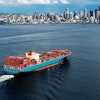Trade Agreements


Digital Trade Rules Benefit Every Sector of the U.S. Economy
Strong digital rules are critical to growth, innovation, and hiring, from autos to agriculture and manufacturing to financial services.
Learn More
Feature story
The U.S. must work with allies and partners to push forward a vision for digital trade that can secure opportunities for American workers, small businesses, services industries, and others.
Feature story
The world is charging ahead in pursuit of new market-opening trade agreements, but in recent years Washington policymakers have been sitting on the sidelines. Here is why America must lead on trade.
Our Work
As other nations race to achieve their own market-opening trade deals, the United States cannot be left behind. The U.S. Chamber is dedicated to pursuing new trade and investment agreements that uphold and improve our standard of living and our standing in the world. Trade agreements must establish high standards, protect American innovation, and be fully enforceable.
Chamber OnDemand
India and Africa offer relatively untapped markets and unique trade opportunities for U.S. businesses.
Events
- InternationalTransatlantic Business Works Summit 2024Tuesday, April 2308:30 AM EDT - 01:30 PM EDTLearn More
- Small BusinessCO— Small Business DayWednesday, May 0112:00 PM EDT - 02:00 PM EDTLearn More
- Security and Resilience13th Annual Building Resilience ConferenceWednesday, May 15 - Friday, May 1708:00 AM EDT - 03:00 PM EDTLearn More
Latest Content
The Biden administration’s withdrawal of support for important digital trade rules continues to undermine U.S. industry.
This Hill letter was sent to the Members of the House Committee on Ways and Means, on renewal of the Generalized System of Preferences (GSP) trade program.
The U.S. Chamber calls on the Biden Administration to reassert US digital trade leadership and stand up for US businesses and workers facing damaging digital trade barriers abroad.
Whether USTR lists foreign trade barriers in its annual catalogue isn’t a matter of aesthetic judgment, it’s often a question of enforcing the law.
The White House is undermining U.S. leadership on digital trade despite the robust growth of the digital economy.
And why USTR’s reversal on policies supporting its growth are so concerning.
This Coalition letter was sent to the Members of the Senate Committee on Finance and House Committee on Ways and Means, on S. 2115 / H.R. 4307, the "Medical Supply Chain Resiliency Act."
The agenda for MC13 in Abu Dhabi will focus on a small number of hot-button issues, but the business community should focus on these priorities.








